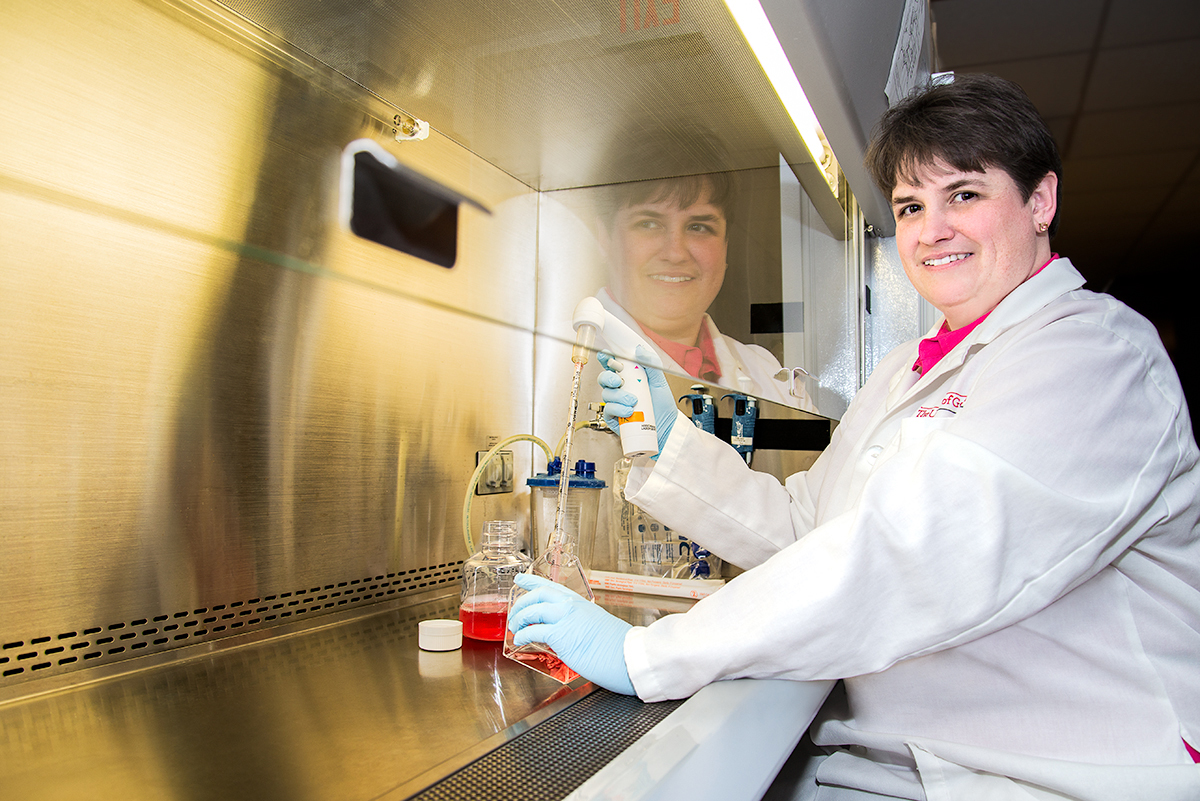Athens, Ga. – Infectious disease researchers at the University of Georgia have identified a signaling protein critical for host defense against influenza infection. The findings, recently published in PLoS Pathogens, shed light on how a single component of the body’s defense system promotes effective immunity against viral infections-particularly respiratory viruses-that affect mucosal sites.
The protein tumor progression locus 2, or Tpl2, is an important regulator of the immune response, controlling signaling downstream of cell surface and intracellular receptors that recognize the presence of pathogens.
Tpl2 regulates the production of a group of immune signaling proteins called interferons. Though interferon production is known to play a large role in host defense against viral infections, prior to this study little was known about how Tpl2 functions in that environment. The study demonstrates a key role for Tpl2 in induction of antiviral genes, including Type III interferons, a type of immune signaling protein, important in mediating antiviral responses.
“Tpl2 regulates inflammation and inflammation is a necessary part of a host’s defense against infection,” said Wendy Watford, corresponding author on the study and an associate professor of infectious diseases in the UGA College of Veterinary Medicine. Ongoing projects in Watford’s lab seek to understand how Tpl2 modulates the host immune response in different disease settings.
Watford and Teneema Kuriakose, her former graduate student and lead author on the study who is now a postdoctoral research associate in the department of immunology at St. Jude’s Children’s Research Hospital, collaborated with Ralph Tripp, a professor and GRA Eminent Scholar of infectious diseases, to study influenza virus infection in mice in which the gene that encodes Tpl2 had been removed.
The Tpl2 knockout mice were more susceptible to influenza infection, exhibiting an average of tenfold higher amounts of virus in the lungs compared to mice with functional Tpl2. At the same time that lung viral titers were high in the Tpl2 knockout mice, the number of cytotoxic T cells—an adaptive immune cell that is key to clearing influenza from the lungs—was significantly reduced.
Although Tpl2 knockout mice produced the Type I interferons that are important players in host antiviral responses at levels equivalent to those seen in wild-type mice, they produced diminished levels of Type III interferons. This finding is important, as Type III interferons are highly expressed at mucosal sites, and are now appreciated to be the most prominent interferon type produced during influenza infection.
“Type III interferons, which are relative newcomers to the field of interferons, are functionally related to the Type I interferons and induce similar antiviral responses,” Watford said. “We are currently investigating whether Tpl2 regulation of Type III interferon production is an essential component of host resistance to influenza.”
The results of this study go a long way toward helping understand the host immune response not just to influenza, but also to other viruses that infect mucosal sites, such as respiratory syncytial virus and rotavirus. This understanding of how the body fights such viruses could help guide the design of more effective countermeasures against viral infections. However, more work needs to be done to fully understand how Tpl2 modulates the immune response during viral infections.
“Ultimately the goal is to generate better vaccines so that we can drive immunologic memory and protect people against subsequent infections,” Watford said.
The study on “Tumor Progression Locus 2 Promotes Induction of IFNλ, Interferon Stimulated Genes and Antigen-Specific CD8+ T Cell Responses and Protects against Influenza Virus” is available at http://journals.plos.org/plospathogens/article?id=10.1371/journal.ppat.1005038.
Research reported in this publication was supported by the National Institute of Arthritis and Musculoskeletal and Skin Diseases under award number K22AR053953 and the National Institute of Allergy and Infectious Diseases under award number R01AI099058 and by startup funds provided by the UGA Office of the Vice President for Research.
College of Veterinary Medicine
The UGA College of Veterinary Medicine, founded in 1946, is dedicated to training future veterinarians, conducting research related to animal and human diseases and providing veterinary services for animals and their owners. Research efforts are aimed at enhancing the quality of life for animals and people, improving the productivity of poultry and livestock and preserving a healthy interface between wildlife and people in the environment they share. The college enrolls 114 students each fall out of more than 1,100 who apply. For more information, see www.vet.uga.edu.


